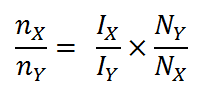Updated on Nov 25th 2021
- What do I need to carry out SMA analysis?
-
The only basic requirement is to have a component with at least one peak area in a defined region of a spectrum and to know the number of nuclei which generate the peak. The SMA plugin will use the integral value of this peak to quantify the species in mixtures with a discrete number of components.
- When is SMA useful?
-
SMA is a workflow designed for targeted screening and quantification of components in mixtures. It allows you to determine the concentration of various components simultaneously and is therefore useful when analyzing mixtures of medium complexity, or when determining the purity of samples which are known to regularly contain high levels of impurity that would never be considered as ‘pure’ samples.
SMA’s workflow suits regulated environments where the same compounds and analytical conditions are repeated, and fine control over the analysis is needed.
An automated batch or Real time version of SMA is also useful when medium to high throughput and minimal operator intervention is required (Gears SMA).
- What sort of industry or applications would benefit from SMA?
-
The SMA method is applicable to a wide range of real-world mixtures either in industry or academia such as:
- Polymer and monomer production
- Quality control of home and personal care products
- Quality control of foods and beverages, such as coffee
- Forensics
- Cosmetics
- Identification of metabolites in body fluids
- Impurity level determination in fine chemicals, including solvents
- Quality control of edible oils
- Wines and fortified alcoholic drinks
- Fruit juices
- Nutraceuticals
- What actually happens in the background when pressing the SMA Analyze button?
-
When you hit the ‘Analyze button’, peak picking is applied and multiplets are determined for each region. Then components are quantified using a predefined mixture analysis which converts the integrals to concentrations according to the specified equation. Each component is evaluated in turn and any errors are hidden. Finally, customized results are displayed in the results table and mixture components are highlighted on the spectrum.
- Do I have the flexibility to use different types of quantification methods?
- Yes, you have full control of your quantification method specifying the integral regions to be used, and using the equation editor.SMA offers you the flexibility to define the way you quantify your mixtures.These integrals are converted into relevant concentrations using user-defined mathematical expressions. Sample-specific data (weights, etc.) may be required depending on the quantification method used: , Purity%, Mole%, Concentration, etc. See Q: What sort of calculation does SMA use for quantification?
- What sort of calculation does SMA use for quantification?
-
SMA is a versatile tool which allows you to specify the formula for your calculations. Integral values are converted into relevant concentrations using mathematical expressions. SMA has all the standard equations for determining Purity, Mass% and Concentration. It’s also easy to define any other equation for concentration by creating a User Defined Equation. For more information about it see our blog post
- For simple molar ratios between two components you can use the following the general expression:

- If for instance you want to estimate the concentration of your mixtures components, then the concentration is determined using the simple equation:
 The Concentration Conversion Factor (CCF) is like a response factor for NMR that converts the absolute integral/nuclide to concentration. For more information about the CCF factor please see Q: What exactly is the CCF factor?
The Concentration Conversion Factor (CCF) is like a response factor for NMR that converts the absolute integral/nuclide to concentration. For more information about the CCF factor please see Q: What exactly is the CCF factor?- Alternatively if you are aiming to calculate the purity of your mixture components, once you create at least one reference material, the fundamental equation for purity (see below) can be applied.

- How efficient is it to use SMA in a production environment?
-
SMA is a versatile tool which can optimize your production process. It can be easily implemented in your workflow for single, batch, or Real time mixture analyses. Methods/SOPs can be saved and used repetitively for consistent results and can be reviewed and updated by experts when required. Methods for as many analyses as needed can be created. Results and reports can be customized. An internal database can be created. Periodic checks of procedures and results will be required for compliance with standards (GxP).
- Is automatic NMR processing used? (i.e. peak picking, integration)
-
SMA enables you to create a fully automated analytical workflow. That means that spectral processing, peak picking, and integration can all be automated. SMA makes use of all the amazing Mnova features, such as processing templates, and accesses all the peak picking and integration options available in the Mnova NMR plugin, including Global Spectral Deconvolution (GSD) which automatically detects and identifies solvents and low-level impurities.
- What exactly is the CCF factor?
- CCF stands for Concentration Conversion Factor or the Spectrometer Factor. Basically, when the area of a multiplet is determined, this is related to its concentration
C ∝ AI/NN (1)
Where C is the concentration of a chemical species, AI is the absolute integral for a multiplet attributable to that species, and NN is the number of nuclides (Hs, usually) for that multiplet. From this we derive:
C= CCF * AI/NN (2)
A proportionality constant which we call the CCF, allows us to convert a measured AI/NN into a concentration. Fundamentally, the CCF only needs to be determined once for an experiment, and then it is applicable to all chemical species in the reaction! Once that has been performed, all other species concentrations can be determined by applying equation (2), where the AI is determined by the software, and NN is provided by the user. For further information about how to calculate the CCF factor you can read the following qNMR_CCF document.
- What is Peak Pattern Recognition (PPR)?
-
The Peak Pattern Recognition (PPR) is one of Mestrelab´s tools for multiplet extraction from regions where peaks overlap. It uses a spectrum of the pure compound as a reference to find multiplet patterns in a user-defined search window. The tool searches for all peaks within this window in the mixture spectrum and discards those whose integral is greater than a pre-set threshold. Next, the Algorithm tool is called to find the reference spectrum peaks in the set of peaks in the mixture. If found, SMA creates a multiplet and prints (alert window) the probability.
- How do I formulate equations for an analysis?
- Type your formula in the Formula editor then use the automatic Check to see if your formula is correct. In the Formula editor you have legends and some additional options to facilitate your task. You can read more about this in our blog post.
- Can I run various analysis at the same time?
-
Yes, you can run SMA in automation with Mnova Gears (check Gears SMA). This plugin will allow you to process and analyze data files in batches or in real time as the data comes off the spectrometer, and generate reports that are automatically saved to the directory of your choice on your disks or even in the Mnova DB.






